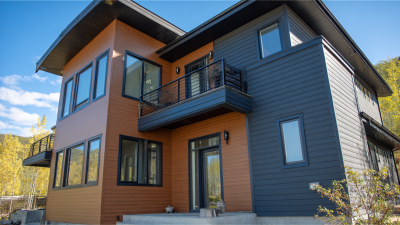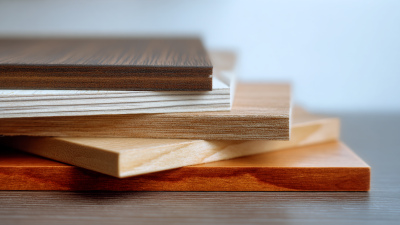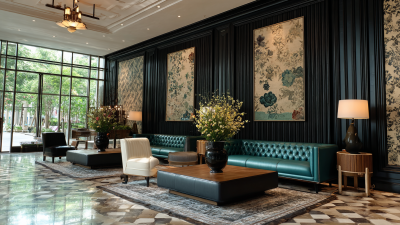How to Choose the Best Wood Plastic Composite Panels for Your Wall Cladding Needs
Table of Contents
- Understanding the Benefits of Wood Plastic Composite Panels for Wall Cladding
- Identifying Key Features to Look for in WPC Panels
- Comparing Different Types of Wood Plastic Composites for Your Project
- Evaluating Aesthetic Options and Finishes for WPC Wall Cladding
- Assessing Durability and Maintenance Requirements of WPC Panels
- Examining Cost-Effectiveness and Environmental Impact of WPC Materials
- Enhancing Outdoor Spaces: 2.9m High-Quality Waterproof WPC Wall Cladding for Stylish Exterior Decoration
- FAQS
- Conclusion
- Related Posts
Lately, there's been a real uptick in the push for using more sustainable building materials. One thing that's been gaining a lot of attention is Wood Plastic Composite Panels (or WPC) for wall cladding—even if you haven’t heard of them before, chances are you’ve seen them in newer buildings. According to a report from Smithers, the worldwide WPC market is projected to hit about 6 billion dollars by 2025, mostly because folks are now more focused on eco-friendly construction options. Companies like Shandong WALLART New Building Material Co., Ltd. are really stepping up—they produce top-notch WPC products for both indoor and outdoor use, giving builders and designers stylish, durable options that stand up to the elements. WPC wall cladding is pretty impressive—resisting moisture, rot, and UV rays—making it a go-to choice for all sorts of environments. If you’re trying to pick out the best WPC panel for your project, it’s worth paying attention to things like the material mix, how smooth or textured the surface is, and how it holds up over time. After all, you want your investment to not only look good but also perform well in the long run.

Understanding the Benefits of Wood Plastic Composite Panels for Wall Cladding
Lately, Wood Plastic Composite (WPC) panels have really taken off when it comes to wall cladding. They’re loved because they mix natural wood fibers with synthetic plastics – kind of like getting the best of both worlds. One of the biggest perks? Durability. Unlike regular wood, these panels are pretty resistant to moisture, bugs, and rot, which makes them super versatile for both indoor and outdoor use. Plus, since they last longer and need less maintenance, you’re saving money in the long run and your investment stays looking good for ages.
On top of that, WPC panels are actually quite environmentally friendly. Many brands use recycled materials to make them, which helps cut down on waste and supports greener building practices. They also offer good insulation, so your home stays comfy without cranking up the energy bills. And don’t worry about missing the natural wood look – these panels come in all kinds of textures and finishes that can mimic real wood pretty convincingly. So, whether you're after that classic warm vibe or something more modern, WPC panels give you a stylish, sustainable option without sacrificing performance.
Overall, they’re a smart choice for anyone wanting durable, eco-friendly, and good-looking wall cladding.

Identifying Key Features to Look for in WPC Panels
When you're choosing wood plastic composite (WPC) panels for your wall cladding, it’s pretty important to know what to look for to make sure they’re durable and perform well. First off, pay attention to what the material’s made of. A good-quality WPC panel will usually be a pretty well-balanced mix of wood fibers and plastic. That combo helps make the panel stronger and more resistant to moisture, which is a big plus. Also, check if the manufacturer mentions how much wood is actually in there—more wood often means a more natural look and feel, which a lot of folks really appreciate.
Another thing to keep in mind is how well the panels handle temperature swings and sunlight—UV rays, in particular. The better products will have special additives that fight fading and prevent warping over time. It’s also worth looking into how they’re made; panels made through co-extrusion usually have a tougher, more protected surface compared to the traditional manufacturing methods. Oh, and don’t forget to see if there’s a solid warranty—this usually shows the manufacturer stands behind their product, and it’s definitely comforting to know you’re covered just in case something goes wrong down the line.
Comparing Different Types of Wood Plastic Composites for Your Project
When you're thinking about choosing wood plastic composite (WPC) panels for your wall cladding, it’s pretty important to get a good grip on the different types out there. Basically, there are two main kinds: capped and uncapped. Capped WPCs have a polymer coating on the surface, which gives them extra protection against moisture and UV rays—making them a solid choice if you’re installing them outside. On the flip side, uncapped versions are usually cheaper and can look great, but they might need a bit more care over time to keep them in good shape and prevent damage.
A couple of tips though—if you live somewhere with crazy weather, capped WPCs tend to hold up better thanks to their durability. Also, don’t forget to think about how they look; a lot of WPC options come in different colors and finishes, so you can pick something that really matches your style.
And here’s another thing to keep in mind—sustainability. Some brands use recycled materials to make their WPCs, which is awesome if you’re into eco-friendly building. It’s always a good idea to ask for certifications or proof that the product is environmentally friendly. Not only does that help the planet, but it also means you’re getting a higher quality, longer-lasting product for your wall. So yeah, take your time, weigh your options, and pick what’s best for your space and your values.
Evaluating Aesthetic Options and Finishes for WPC Wall Cladding
When you're choosing wood plastic composite (WPC) panels for wall cladding, thinking about the looks and finishes is honestly a pretty big deal. WPC is super versatile—you can find it in all sorts of colors, textures, and finishes that can really suit both modern and traditional styles. I recently came across a report from the Wood Plastic Composites Market Analysis, which says that the global demand for WPC is expected to grow about 10% each year. That makes sense when you consider how good it looks combined with its durability and how low-maintenance it is.

On top of that, the finish of the WPC panels really makes a difference—they can impact how nice they look and how long they last. Nowadays, manufacturers are offering all kinds of surface options, like embossed textures or smooth finishes that mimic real wood. A study by the American Architectural Manufacturers Association even points out that finishes with UV protection not only make them look better, but also help keep them looking fresh longer by preventing fading and damage caused by the weather. If you think about these factors carefully, homeowners and designers can come up with some really stunning wall cladding choices that are both practical and visually appealing.
Assessing Durability and Maintenance Requirements of WPC Panels
So, if you're thinking about using wood plastic composite (WPC) panels for wall cladding, it's really worth understanding how durable they are and what kind of upkeep they need. I came across a report from the Wood Plastic Composites Research Group, and it turns out that WPCs tend to last way longer than regular wood panels — we're talking about 25 to 30 years if you give them proper care. That’s pretty impressive, right? The secret sauce is their resistance to rot, bugs, and weather damage, which makes them a smart choice for all kinds of environments.
That said, to make sure those panels stand the test of time, some regular maintenance is still key. Luckily, WPCs don’t need as much fuss as traditional wood — you can usually get away with just a quick clean using mild soap and water. Oh, and while they don’t warp as easily as wood, they can still fade if they’re sunbaked for too long. To keep the color looking fresh, it’s a good idea to apply a UV-protective stain or finish.
Here are a few tips I found helpful:
- When picking out WPC panels, go for those with built-in UV protection to keep the color vibrant and boost their lifespan.
- Make it a habit to clean them regularly — a quick rinse to wash away dirt and mildew helps keep them looking great.
- And finally, choose brands that offer warranties. It’s a good sign they stand behind their products and believe in their durability.
All in all, WPC panels are pretty solid, but a bit of upkeep goes a long way in keeping them looking their best over the years.
Examining Cost-Effectiveness and Environmental Impact of WPC Materials
When you're thinking about wall cladding options, one thing that really stands out is how much the material you pick can influence both your budget and the environment. Lately, Wood Plastic Composite (or WPC) panels have become pretty popular as an alternative. But, honestly, it's worth taking a moment to really get what that means for your wallet and the planet. I came across a report from Grand View Research that's pretty eye-opening—by 2027, the global WPC market is expected to hit around 9.4 billion dollars. The main driver? Growing awareness about building things more sustainably. It’s a good sign because it shows people aren’t just looking for something cheap—they want options that are both affordable over time and eco-friendly. WPC panels tend to last about 25-30 years, which is usually longer than traditional wood, and they often end up costing less in the long run because they don’t need constant repairs and replacements.
Now, from an environmental standpoint, WPC is actually pretty impressive. There’s a study in the Journal of Cleaner Production that points out that WPC can help cut down on deforestation and lowering carbon emissions, mainly because it’s often made from recycled plastics and sustainably sourced wood fibers. In fact, switching to WPC can slash CO2 emissions by up to 40% compared to regular lumber over the entire lifecycle of the product. So, it’s not just kind to your budget, but it’s also a smarter, greener choice if you’re after something durable and more sustainable for your walls.
How to Choose the Best Wood Plastic Composite Panels for Your Wall Cladding Needs - Examining Cost-Effectiveness and Environmental Impact of WPC Materials
| Panel Type | Cost per Square Foot | Lifespan (Years) | Recycled Content (%) | Maintenance Requirements | Environmental Impact |
|---|---|---|---|---|---|
| Standard WPC Panel | $3.50 | 15 | 30 | Low maintenance | Moderate |
| Premium WPC Panel | $5.00 | 25 | 50 | Minimal maintenance | Low |
| Eco-Friendly WPC Panel | $4.50 | 20 | 70 | Occasional cleaning | Very low |
| Composite Panel with Wood Grain Finish | $6.00 | 30 | 40 | Regular maintenance | Moderate |
Enhancing Outdoor Spaces: 2.9m High-Quality Waterproof WPC Wall Cladding for Stylish Exterior Decoration
Enhancing outdoor spaces has never been easier with the introduction of high-quality 2.9m waterproof WPC wall cladding. This innovative co-extruded wall cladding offers the perfect blend of style and functionality, making it an ideal choice for both external and internal applications. With its fluted design, the wall cladding not only provides a sophisticated aesthetic but also boasts impressive durability and weather resistance, ensuring it withstands the harshest conditions while maintaining its allure.
Crafted from wood plastic composite (WPC), this cladding material replicates the natural appearance of premium timber, without the ongoing maintenance associated with traditional wood products. The co-extrusion process enhances its resilience while allowing for a diverse range of colors and profiles that cater to any design vision. Whether you're looking to enhance a building's facade or create a striking garden feature, this low-maintenance solution promises ease of installation and cleaning, making it perfect for modern outdoor aesthetics. Plus, its eco-friendly composition helps save forest resources, making it a responsible choice for environmentally-conscious decorators.
FAQS
: WPC panels are durable, resistant to moisture, insects, and rot, making them suitable for both indoor and outdoor applications. They also have lower maintenance costs and a longer lifespan.
Many manufacturers use recycled materials in the production of WPC panels, reducing waste and promoting eco-friendliness in construction.
Look at the material composition, ensuring a balanced mix of wood fibers and plastic for strength and moisture resistance. Also, consider temperature and UV resistance, surface protection methods, and warranty availability.
Capped composites have a protective polymer layer that enhances resistance to moisture and UV rays, making them ideal for outdoor use, while uncapped composites are more affordable but may require more maintenance.
Consider using capped composites if you live in an area with extreme weather conditions due to their enhanced durability.
Yes, WPC panels come in various colors and finishes that can mimic the appearance of natural wood, allowing homeowners to match their architectural style.
Ask for certifications that verify the use of recycled materials and the overall eco-friendliness of the WPC products you are considering.
Panels produced through co-extrusion generally offer better surface protection compared to those made through traditional methods, impacting their longevity and performance.
A higher percentage of wood in WPC panels typically results in better aesthetics and a more natural feel. Look for panels that specify their wood content.
A reliable warranty indicates the manufacturer’s confidence in their product and offers assurance against potential issues, ensuring long-term satisfaction.
Conclusion
So, I came across this article titled 'How to Choose the Best Wood Plastic Composite Panels for Your Wall Cladding Needs,' and honestly, it feels like a pretty useful guide if you're thinking about using WPC panels. It kicks off by highlighting why these panels are a smart choice — stuff like their durability, the way they look, and how low-maintenance they are. Then, it walks you through the key features to look out for, including the different types of composites suited for various projects.
What’s pretty cool is that it also dives into the aesthetic options and finishes, giving homeowners a chance to really customize their space. Plus, it emphasizes how WPC is not just cost-effective but also eco-friendly — making it a smart, sustainable pick for modern building projects. The folks at Shandong WALLART New Building Material Co., Ltd. seem to really know their stuff, especially when it comes to creating top-quality WPC products for both inside and outside use.
Related Posts
-

Essential Guide to Choosing the Right WPC Wall Siding for Your Project Based on Industry Trends
-

How to Choose the Right WPC Wall Panel for Optimal Durability and Aesthetic Appeal
-

How to Choose the Perfect Home Interior Wall Paneling for Your Space
-

How to Elevate Your Space with PVC Decorative Wall Paneling: A Complete Guide
-

5 Essential Tips to Determine the Best WPC Wall Panel Prices in India
-

How to Elevate Your Space with Wpc Fluted Wall Design
Blog Tags:

Liam
-

Phone
-

E-mail
-

WhatsApp
Send Us A Message
Get Price And Free Samples Right Now!

